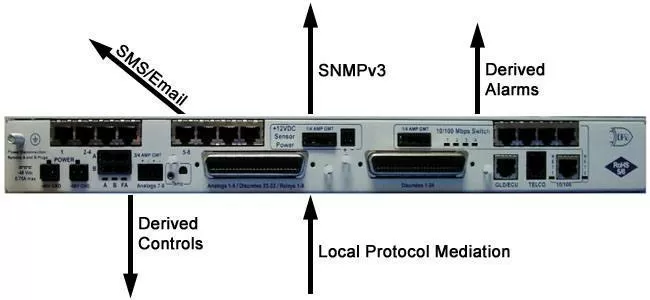5 helpful functions of modern RTUs
It's obvious that any "SNMP RTU" must support SNMP (at least one version of it). If that's all you look for when making a purchase decision, however, you're probably missing out on opportunities to make your network more reliable, more profitable, and easier to manage effectively. Here's a list of important functions to look for that allow an RTU to perform functions beyond simple SNMP:

- SMS/email notifications
Sometimes (whether it's after normal business hours or simply a critical alarm), you just want an alert sent directly to you. Maybe you don't have a 7x24 NOC center, or maybe they're simply taking a bit too long to notify you. Whatever the reason, you simply can't afford a delay when an important alarm comes in. A quality SNMP RTU can be configured to simultaneously send an SMS text and/or email message when it sends an SNMP trap. Be sure that you're able to select which alarms trigger alert messages, as it's probably just a few of the most important conditions that deserve to reach you directly. - SNMPv3 for encrypted security
If you work at a large organization, especially a government entity, you need to be concerned about security. SNMP v1 and v2c weren't designed with security in mind. If your network is breached, your SNMP traffic will be easy to view (or even manipulate). Intruders can range from mischievous vandals to determined terrorists, and you can protect yourself from all of them by adding layers of encryption to your network management. That's why encrypted SNMPv3 traps have been mandated by many governments and corporations. - Local protocol mediation
If you're like most companies, you have a good amount of older equipment in your network. As long as it still functions, it's a shame to throw gear out and spend budget dollars on something else. This does mean, however, that you're going to have some older protocols and interfaces that you need to handle. Dedicated serial circuits have been mostly replaced by IP, so how do you transport legacy serial-based alarms? What you need is an SNMP RTU that can also collect legacy protocol alarms (ex. TL1 or TBOS or TABS protocol) and convert them to SNMP traps. Those SNMP traps can be reported along with any "typical" traps generated via discrete contact closure inputs or analog sensors. - Derived alarms
Not every problem can be properly detected with a single measurement. Consider that a "Commercial Power Failure" alarm might be a major (but not a critical) alarm. It's very important, but not an imminent disaster as long as you have battery power and/or a generator available. Similarly, a low battery or low generator fuel also might be a major (but not a critical alarm). Unless your commercial power is very unreliable, this isn't a tremendous emergency. But what if both situations happen at the same time. Does a pair of major alarms adequately address the fact that you have no commercial power and are about to have the site go dark when batteries/generators run dry? Obviously not. In this case, you need an SNMP RTU that's intelligent enough to trigger a pre-programmed critical alarm that's "derived" from other alarms. - Derived controls
It's one thing for an SNMP RTU to "understand" (via pre-programming) that two related alarms should trigger a higher-severity alarm when they occur simultaneously (see "Derived alarms" above), but it's even better if the RTU can automatically react to the situation. Continuing from our "Derived alarms" example above, remember that commercial power has failed at the remote site, and the batteries are almost completely drained. If the site has a good redundant design, it should also have a standby generator for situations just like this one. Your RTU simply needs to activate the generator. If your RTU supports "Derived controls", it can do just that. When commercial power fails AND batteries are low, the RTU will latch a control relay to trigger generator startup. It will then send SNMP traps back to your SNMP manager to report both the alarm conditions AND the triggered response. Imagine that. Your RTU is smart enough to understand the imminent threat of a power loss, fast enough to activate the standby generator within a few seconds, then considerate enough to send a full report back to you. That truly goes beyond simple SNMP.
As you can see, a good SNMP remote can do much more than simply send out SNMP traps. Now that you have some background information, you're ready to review some real-world RTU examples.

